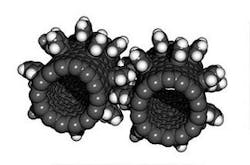Oil companies are branching out, buckyballs and all.
ChevronTexaco Corp. last December reported that its Energy Research & Technology Co. in Richmond, Calif., had discovered a new class of molecular building blocks called "high diamondoids." Found in petroleum, these nanometer-sized carbon-based materials may be instrumental in advancing the field of nanotechnology. A nanometer is one billionth of a meter.
Nanotechnology is rapidly evolving as a field that develops materials with superior properties derived from building at the molecular level. The US, Japan, and other governments are funding its development at a rate of more than $2 billion/year.
Expected to change our way of life in many ways—or perhaps more realistically our grandchildren's—new molecular nanotechnology is emerging from the discovery in 1985 of a little carbon 60 molecule called the "buckyball."
This spherical molecule is a very stable, hollow cluster of 60 carbon atoms joined together in a geodesic domelike structure resembling a soccer ball. The polygon has 12 pentagon faces, 20 hexagon faces, and 60 vertices—like the geodesic domes US architect Buckminster Fuller created—so the two chemists who discovered it named it the buckminsterfullerene, or buckyball.
After the buckyball's discovery, scientists discovered a whole family of related fullerene molecules having 28-240 carbon atoms, a discovery for which three of them won the Nobel Prize in chemistry.
Nanotubes
Buckyball codiscoverer Rice University Prof. Richard Smally and a colleague then shaped the fullerenes into pipes, or carbon "nanotubes," which are only about one billionth of a meter in diameter but are very durable. They have a tensile strength 100 times greater than steel but have only one sixth the weight and, when crushed, return to their original shape. They also have the electrical conductivity of copper and the thermal conductivity of diamond.
null
Ames Research Center, Mountain View, Calif., in cooperation with researchers at the National Aeronautics & Space Administration, in a computer simulation created microscopic "engines" using nanotubes with benzene molecules attached to the outside as gears, cooling it with helium and neon gases, as the gears would turn at 6 trillion rpm. They simulated a laser to drive the gears in an electrical field with positively charged atoms on one side and negatively charged atoms on the other. The simulation showed the possibility of creating such nanomachines, but Ames said the technology may be decades away from commerciality.
ChevronTexaco said its diamondoids, some of which weigh less than a billionth of a billionth of a carat, also possess "superb characteristics for nanotechnology—rigidity, durability, multiple shapes and sizes, and potential for precise self-assembly."
Research support
The White House has identified nanotechnology as a critical research area, and at least 11 US government agencies currently are funding molecular nanotechnology research, including NASA and the departments of Energy and Defense. Along with Rice, Massachusetts Institute of Technology, Stanford University, and Cornell University also conduct nanotechnology research. Much of the research will take more than 20 years to complete.
Another major oil company, ConocoPhillips, last February invested capital and intellectual property rights in SouthWest NanoTechnologies Inc., which enabled SouthWest to begin construction of a pilot plant to manufacture its "CoMoCAT" single-wall carbon nanotubes at a cost low enough to accelerate their commercialization. Until now, nano- tubes were scarcely available and cost as much as $500/g. SouthWest was incorporated in April 2001 to spin off nanotube research developed at the University of Oklahoma. In return for its investment, Conoco- Phillips gained an equity position in SouthWest.
And Altair Nanotechnologies Inc. reported last month that Telecordia Technologies, using Altair's nanomaterials, has developed battery prototypes based on Altair's nano-sized lithium titantate spinel. The prototype, developed for use in hybrid automobiles, exceeds DOE's standards for battery-specific energy storage and power delivery at 95% efficiency, Altair said.
And oil and gas companies are in the thick of the hunt.

